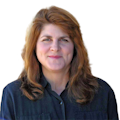Perovskite quantum dots are brighter, faster than other dot designs
Researchers from ETH Zurich, IBM Research Zurich, Empa (also in Zurich, Switzerland), and colleagues in America have made headway in understanding why quantum dots composed of cesium-lead-halide (CsPbX3) compounds are much brighter and radiate much faster than other engineered quantum dots.
At room temperature, most quantum dots emit light with a typical radiative decay time of 20 ns. However, CsPbX3 quantum dots emit light with a strongly accelerated radiative decay, both at room and cryogenic temperatures. To unveil the secret, the authors used experimental data obtained at the single-particle level, in combination with theoretical work led by Alexander Efros, a theoretical physicist at the Naval Research Laboratory (Washington, DC). They discovered that the emission originates from bright triplet states—no dark states were involved in the radiation process. Already, the dots are being explored for displays, light-emitting diodes, and for optical communications—the researchers say this quantum-dot breakthrough could enable the development of more efficient optoelectronic devices. Reference: M. A. Beckeret al., Nature, 553, 7687, 189–193 (Jan. 11, 2018).
About the Author

Gail Overton
Senior Editor (2004-2020)
Gail has more than 30 years of engineering, marketing, product management, and editorial experience in the photonics and optical communications industry. Before joining the staff at Laser Focus World in 2004, she held many product management and product marketing roles in the fiber-optics industry, most notably at Hughes (El Segundo, CA), GTE Labs (Waltham, MA), Corning (Corning, NY), Photon Kinetics (Beaverton, OR), and Newport Corporation (Irvine, CA). During her marketing career, Gail published articles in WDM Solutions and Sensors magazine and traveled internationally to conduct product and sales training. Gail received her BS degree in physics, with an emphasis in optics, from San Diego State University in San Diego, CA in May 1986.
